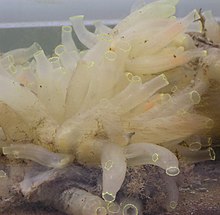
Back كيسيات Arabic كيسيات ARZ Asisidlər Azerbaijani آسیسیدلر AZB Асцыдыі Byelorussian Асцидии Bulgarian Ascidis Catalan Ascidiacea CEB Sumky Czech Søpunge Danish
| Ascidiacea Temporal range:
| |
|---|---|

| |
| Ciona intestinalis, commonly known as the vase tunicate or as a sea squirt | |
| Scientific classification | |
| Domain: | Eukaryota |
| Kingdom: | Animalia |
| Phylum: | Chordata |
| Subphylum: | Tunicata |
| Class: | Ascidiacea Blainville, 1824 |
| Groups included | |
| |
| Cladistically included but traditionally excluded taxa | |
| |
Ascidiacea, commonly known as the ascidians or sea squirts, is a paraphyletic class in the subphylum Tunicata of sac-like marine invertebrate filter feeders.[2] Ascidians are characterized by a tough outer "tunic" made of a polysaccharide.
Ascidians are found all over the world, usually in shallow water with salinities over 2.5%. While members of the Thaliacea (salps, doliolids and pyrosomes) and Appendicularia (larvaceans) swim freely like plankton, sea squirts are sessile animals after their larval phase: they then remain firmly attached to their substratum, such as rocks and shells.[citation needed]
There are 2,300 species of ascidians and three main types: solitary ascidians, social ascidians that form clumped communities by attaching at their bases, and compound ascidians that consist of many small individuals (each individual is called a zooid) forming large colonies.[3]
Sea squirts feed by taking in water through a tube, the oral siphon. The water enters the mouth and pharynx, flows through mucus-covered gill slits (also called pharyngeal stigmata) into a water chamber called the atrium, then exits through the atrial siphon.[citation needed]
Some authors now include the thaliaceans in Ascidiacea, making it monophyletic.[4]
- ^ Fedonkin, M. A.; Vickers-Rich, P.; Swalla, B. J.; Trusler, P.; Hall, M. (2012). "A new metazoan from the Vendian of the White Sea, Russia, with possible affinities to the ascidians". Paleontological Journal. 46 (1): 1–11. Bibcode:2012PalJ...46....1F. doi:10.1134/S0031030112010042. S2CID 128415270.
- ^ Gittenberger, A.; Shenkar, N.; Sanamyan, K. (2015). "Ascidiacea". In: Shenkar, N.; Gittenberger, A.; Lambert, G.; Rius, M.; Moreira Da Rocha, R.; Swalla, B. J.; Turon, X. (2017). Ascidiacea World Database. Accessed through: World Register of Marine Species on 2017-09-15.
- ^ Alié, Alexandre; Hiebert, Laurel S.; Scelzo, Marta; Tiozzo, Stefano (2021). "The eventful history of nonembryonic development in tunicates". Journal of Experimental Zoology Part B: Molecular and Developmental Evolution. 336 (3): 250–266. Bibcode:2021JEZB..336..250A. doi:10.1002/jez.b.22940. ISSN 1552-5015. PMID 32190983. S2CID 213181394.
- ^ Brusca, Richard C.; Giribet, Gonzalo; Moore, Wendy (2023). Invertebrates (4th ed.). New York: Oxford University Press. pp. 911–932.